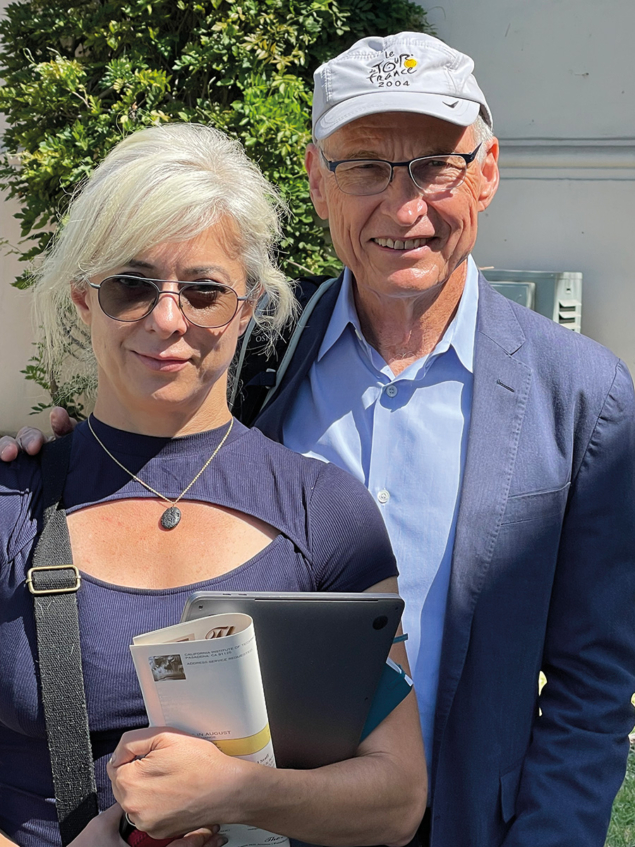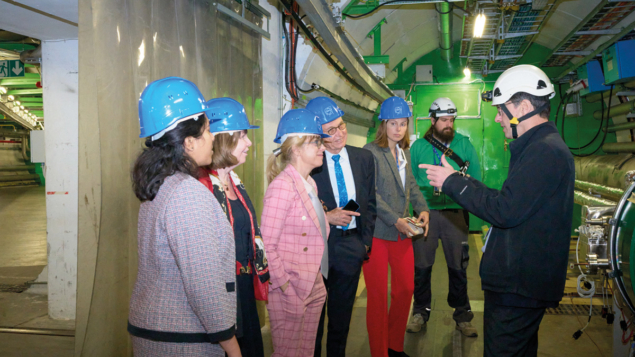Maria Spiropulu and Michael Turner discuss Elementary Particle Physics: Progress and Promise (EPP-2024), a committee charged with submitting a report on the long-term future of elementary particle physics in the US.

What is the origin and purpose of EPP-2024?
Michael Turner (MT): In June 2022, the US Department of Energy (DOE) and National Science Foundation (NSF) asked the US National Academy of Sciences to convene a committee to provide a long-term (30 years or more) vision for elementary particle physics in the US and to deliver its report in mid 2024. EPP-2024 follows three previous National Academy studies, the last one in 2006 being notable for its composition (more than half of the members were “outsiders”) and the fact that it both set a vision and priorities. EPP-2024 is an 18-member committee, co-chaired by Maria and myself, and comprises mostly particle physicists from across the breadth of the field. It includes two Nobel Prize winners, eight National Academy members and CERN Director-General Fabiola Gianotti. It will recommend a long-term vision, but will not set priorities.
How does EPP-2024 relate to the current “P5” prioritisation process in the US?
MT: The field is in the process of the third P5 (Particle Physics Project Prioritization Panel) exercise, following previous cycles in 2008 and 2014. The DOE and the NSF asked the 30-member P5 committee (chaired by Hitoshi Murayama of UC Berkeley) to provide a prioritised, 10-year budget plan in the context of a 20-year globally-aware strategy by October 2023. By way of contrast, EPP-2024 will assess where the field is today, describe its ambitions and the tools and workforce necessary to achieve those ambitions, all without discussing budgets, specific projects or priorities.
Both P5 and EPP-2024 have benefitted from the community-based activity, Snowmass 2021, sponsored by the American Physical Society, which brought together more than 1000 particle physicists to set their priorities and vision for the future in a report published in January 2023. Together, EPP-2024 and P5 will provide both a long-term vision and a shorter-term detailed plan for particle physics in the US that will maintain a vibrant US programme within the larger context of a field that is very international.
What took EPP-2024 to CERN earlier this year?
Maria Spiropulu (MS): CERN, from its inception, has been structured as an international organisation; pan-European surely, but structurally internationally ready. In 2018 I was in the Indian Treaty room of the White House when the then CERN Director-General Rolf Heuer proclaimed CERN as the biggest US laboratory not on US soil. Indeed, in the past decade the ties between US particle physics and CERN have become stronger – in particular via the LHC and HL-LHC and also the neutrino programme – and ever more critical for the future of the field at large, so it was only natural to visit CERN and to discuss with the community in our EPP Town Hall, the early-career contingent and others. It was a very productive visit and we were impressed with what we saw and learned. The early-career scientists were fully engaged and there was a long and lively discussion focused both on the long-term science goals of the field, the planning process in Europe and in the US, the role of the US at CERN and CERN’s role in the US, as well as the involvement of early-career researchers in the process. As the field evolves and innovative approaches from other domains are employed to address persistent science questions and challenges, we see our workforce as a major output of the field both feeding back to our research programme and the society writ large.
The questions we are asking now are big questions that require tenacity, resources, innovation and collaboration. Every technology advance and invention we can use to push the frontiers of knowledge we do. Of course, we need to investigate whether we can break these questions into shorter-timescale undertakings, perhaps less demanding in scale and resources, and with even higher levels of innovation, and then put the pieces together. Ultimately it is the will and determination of those who engage in the field that will draft the path forward.
How would you define particle physics today?
MT: There is broad agreement that the mission of particle physics is the quest for a fundamental understanding of matter, energy, space and time. That ambitious mission not only involves identifying the building blocks of matter and energy, and the interactions between them, but also understanding how space, time and the universe originated. As evidenced by the diversity of participants at Snowmass – astronomers and physicists of all kinds – the enterprise encompasses a broad range of activities. Those being prioritised by P5 range from experiments at particle accelerators and underground laboratories to telescopes of all kinds and a host of table-top experiments.

Long ago when I was an undergraduate at Caltech working with experimentalist Barry Barish (now a gravitational-wave astronomer), particle physics comprised experimenters who worked at accelerators and theorists who sought to explain and understand their results. While these two activities remain the core of the field, there is a “cloud” of activities that are also very important to the mission of particle physics. And for good reason: almost all the evidence for physics beyond the Standard Model involves the universe at large: dark matter, dark energy, baryogenesis and inflation. Neutrino masses were discovered in experiments that involved astrophysical sources (e.g. the Sun and cosmic-ray produced atmospheric neutrinos), and many of the big ideas in theoretical particle physics involve connecting quarks and the cosmos. Although some of the researchers involved in such cloud activities are particle physicists who have moved out of the core, the primary research of most isn’t directly associated with the mission of particle physics.
We stand on the tall shoulders of the Standard Model of particle physics – and general relativity – with a programme in place that includes the LHC, neutrino experiments, dark-matter and dark-energy experiments, CMB-polarisation measurements, precision tests and searches for rare processes and powerful theoretical ideas – not to mention all the ideas for future facilities. I believe that we are on the cusp of a major transformation in our understanding of the fundamentals of the physical world at least as exciting as the November 1974 revolution that brought us the Standard Model.
How can particle physics maintain its societal relevance next to more applied domains?
MS: To be sure, the edifice of science is ever more relevant to human civilisation and most of society’s functions. Particle physics and associated fields capture human imagination and curiosity in terms of questions that they grapple with – questions that no one else would take up, at least not experimentally. All science domains, technology-needs and products are important to our 21st-century workings. Particle physics is not more or less important, in fact it consumes and optimises and adapts the advances of most other domains toward very ambitious objectives of building an understanding of our universe. I would also argue that because we are the melting pot of so much input and tools from other seemingly unrelated science and technology domains, the field offers a very fertile and attractive ground for training a workforce able to tackle intellectually and technologically ambitious puzzles. It can be seen as overly demanding – and this is where mentorship, guidance and clarity of opportunities play a crucial role.
How does EPP-2024 take into account international aspects of the field?
MS: This is exemplified by a committee membership that includes the CERN Director-General, and also by the multiple testimonies and panels focusing on international collaboration, including the framework, the optimisation of science and societal outcomes, and the training of an outstanding workforce. We have collected information from distinguished panels and experts in Europe, Asia and the US that have traditionally led the field, and we study how smaller economies and nations participate and contribute successfully and to the benefit of their nations and the international discovery science goals at large. We also interrogate the role of our science in diplomacy and in scientific exchanges that may overcome geopolitical tensions. International big projects are not a walk in the park; in our field they have proven to be necessary, so we put in deliberate emphasis to make them work towards achieving ambitious goals that are otherwise intractable.
What has the EPP-2024 committee learned so far – any surprises?
MT: For me, a relative outsider to particle physics, several things have stood out. First, the breadth of the enterprise today: cosmology has become fully integrated into particle physics, and new connections have been made to AMO physics (quantum sensors, trapped atoms and molecules, atomic interferometry), gravitational physics (gravitational waves and precision tests of gravity theory), and nuclear physics (neutrino masses and properties). Not only have dark-matter searches for WIMPs and axions become “big science”, but there is exploration of a host of new candidates that has spurred the invention of novel detection schemes.
I believe that we are on the cusp of a major transformation in our understanding at least as exciting as the November 1974 revolution
In the US, particle physics has become a big tent that encompasses tabletop experiments to look for a small electric dipole moment of the electron, large galaxy surveys, cosmic microwave background experiments, long-baseline neutrino experiments, and of course collider experiments to explore the energy frontier. It is difficult to draw a box around a field called elementary particle physics.
On the science side, much has changed since the last National Academy report in 2006, which noted discovering the Higgs boson and exploring the soon-to-be-discovered world of supersymmetry as its big vision. The aspirations of the field are much loftier today, from understanding the emergence of space and time to the deep connections between gravity and quantum mechanics. At the same time, however, the path forward is less clear than it was in 2006.








